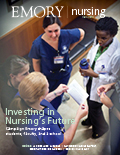Preventing HPV and Cervical Cancer

Tami Thomas is studying rural communities in south Georgia to find appropriate ways to disseminate the HPV vaccine as a way to prevent cervical cancer.
It starts by listening to communities in rural Georgia
|
Reaching a Milestone: Scholarships: Faculty Research: Service-Learning: |
In 2005, a girl in her early 20s came to see Tami Thomas PhD CPNP RNC for a routine Pap smear. Thomas, then a pediatric nurse practitioner with the University of Florida, had to deliver devastating news. The girl had cervical cancer induced by a human papillomavirus (HPV) infection.
“This young woman was at a time in her life when she should have been planning for graduate school or traveling or starting a job,” says Thomas. “Instead she was faced with chemotherapy, radiation, and the possibility of a truncated life. I went to my director and said, ‘Something has to be done about HPV. It’s everywhere.’ ”
Today, she is doing something about it. Now an assistant professor and a Robert Wood Johnson Foundation Nurse Faculty Scholar at Emory, Thomas is researching interventions to disseminate health care innovations, like the new HPV vaccine, to adolescent and pediatric populations experiencing health disparities in rural areas.
“The people who live in rural counties suffer from diseases such as cervical cancer at higher rates than those in urban areas, yet they are often invisible,” she says. “The support I get from Campaign Emory and the Robert Wood Johnson Foundation allows me to help all Georgians.”
HPV is the most commonly acquired sexually transmitted infection (STI) in the United States for those ages 16 to 24, according to the CDC. It is so common that at least 50 percent of sexually active men and women get it at some point in their lives. Unlike many other STIs, HPV can be spread through skin-to-skin contact during sexual play as well as through all types of intercourse. Most people with HPV do not develop symptoms or health problems from it, so they may not even know they have it. In 90 percent of cases, the body’s immune system clears HPV naturally within two years. However, four of the 40 HPV strains have been linked with cervical cancer. In fact, HPV is responsible for more than 70 percent of all cervical cancers.
And cervical cancer hits much harder in rural areas than urban ones. That’s because it is essentially a poor woman’s disease, disproportionately striking women who cannot afford or do not have access to annual Pap smears.

For 10 months, Thomas traveled to four rural counties in southeastern Georgia to meet residents and hear their concerns about HPV vaccination. |
So for adolescents in rural Georgia, getting the HPV vaccine should be a no-brainer, right? Wrong. Vaccination rates are low, possibly for many reasons. It is expensive—the three-injection regimen costs more than $300. Its protection lasts four years and then a booster vaccination is needed and some parents express concern that HPV vaccination promotes sexual promiscuity.
So how does one convince this at-risk population of the benefit of HPV vaccination? That is the crux of Thomas’ current research. To craft a message that resonates with this population and increases vaccination rates, she first has to get inside their heads and hearts.
“I want to produce a culturally specific intervention—a way to promote positive health behaviors in the context of a person’s values,” says Thomas. “I’m talking about where they live, what they eat, where they attend worship services, the roles of women, the roles of children, how they value health, how they value education, how children are raised. You have to look at all that and much more and get to know that population before you can say, ‘Let’s work on changing this behavior,’ whether it’s regarding getting children immunized or any other health promotion behavior.”
So beginning in early 2009, Thomas spent 10 months driving down to four rural southeastern Georgia counties, meeting people in small churches, speaking before local groups, introducing herself around town—and listening. Only after she had gained the confidence of the social gatekeepers did she start to collect her first scraps of data.
“Many times people in these rural and isolated communities suffer from what I call ‘helicopter researchers’—people who fly in, get data and leave, and there’s nothing left in place that really helps them,” says Thomas. “But to understand people, you have to take the time. I had so many people come up to me when I was collecting data who said, ‘You know, no one has ever come down here and asked us what we thought. Usually people want to rush down here and fix us.’ ”
By getting to know her subjects, Thomas presented her research in the context of their values and then when she went to collect data, people understood the purpose and the importance of participating in research. “I went from collecting very small, tiny groups of data to completing my descriptive work early,” she says.
While it is too early to share what she has learned about community members so far, she can attest that they love their children and want to ensure they have long healthy lives, and many know someone who has died of cancer. She hopes to receive funding to pilot her culturally specific intervention within the next year, followed by a large randomized study soon thereafter.
“If it works in rural Georgia, we’ll take the constructs of it, modify the design, and pilot it in the Haitian and rural Afro-Caribbean communities in Florida,” says Thomas. “That’s the big brass ring, the larger career goal for me—creating a model of diffusion for health care innovations to vulnerable populations, whether it’s in south Georgia, Miami, Africa, or India.” -Martha Nolan McKenzie
|
Cervical cancer hits much harder in rural areas than urban ones. That's because it is essentially a poor woman's disease, disproportionately striking women who cannot afford or do not have access to annual Pap smears. |
||||



